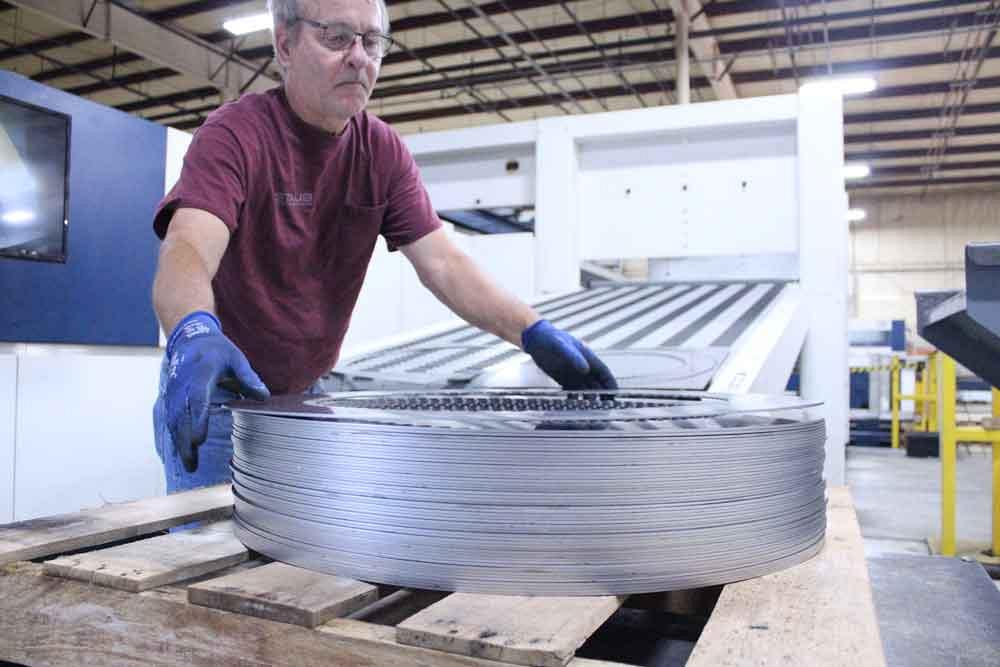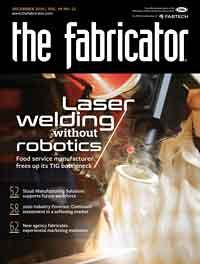Senior Editor
- FMA
- The Fabricator
- FABTECH
- Canadian Metalworking
Categories
- Additive Manufacturing
- Aluminum Welding
- Arc Welding
- Assembly and Joining
- Automation and Robotics
- Bending and Forming
- Consumables
- Cutting and Weld Prep
- Electric Vehicles
- En Español
- Finishing
- Hydroforming
- Laser Cutting
- Laser Welding
- Machining
- Manufacturing Software
- Materials Handling
- Metals/Materials
- Oxyfuel Cutting
- Plasma Cutting
- Power Tools
- Punching and Other Holemaking
- Roll Forming
- Safety
- Sawing
- Shearing
- Shop Management
- Testing and Measuring
- Tube and Pipe Fabrication
- Tube and Pipe Production
- Waterjet Cutting
Industry Directory
Webcasts
Podcasts
FAB 40
Advertise
Subscribe
Account Login
Search
A metal fabricator, the future workforce, and battling robots
Ohio shop spreads the word of manufacturing’s opportunity through robotics
- By Tim Heston
- December 3, 2019
- Article
- Automation and Robotics
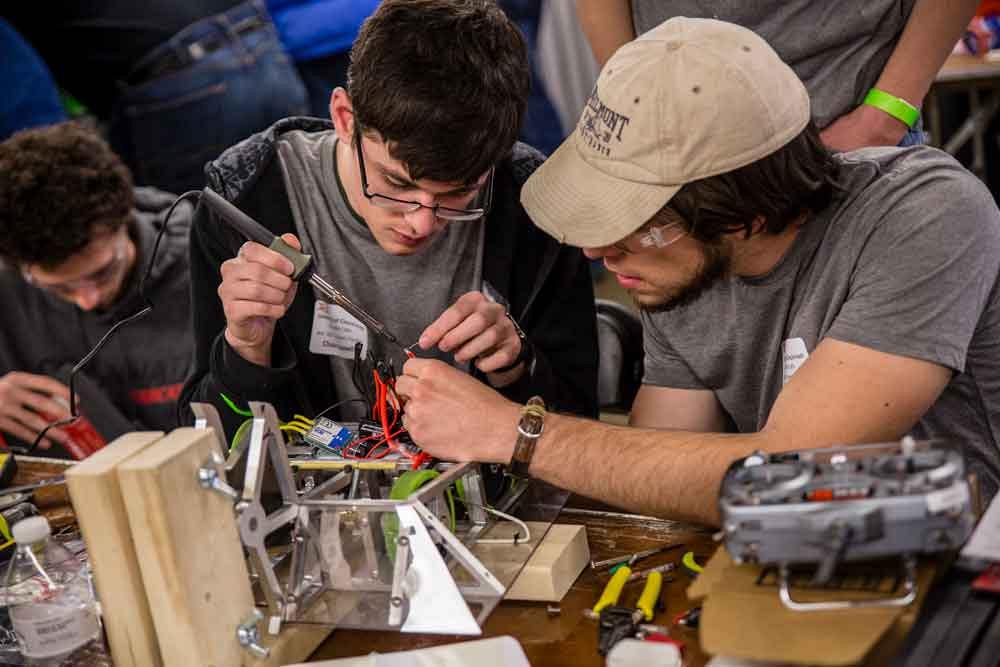
As part of Xtreme STEM’s Xtreme BOT competition, a team of high schoolers solder a bot’s electronics.
A few days a year, groups of Dayton, Ohio-area high schoolers walk into Staub Manufacturing Solutions, a local custom fabricator, with drawings in hand. They often carry hand drawings, but some even bring laptops with 3D CAD files.
They’re killer drawings in the literal sense. Each shows sheet metal that will be fabricated into a robot on a mission: to clobber other robots. All this is part of Xtreme BOTS, a BattleBots-esque competition organized by Xtreme STEM, an educational outreach effort launched by several Dayton business leaders, including Steve Staub, co-founder and president of Staub Manufacturing. The fabricator’s story exemplifies how, despite all the industry’s challenges, so many in this business couldn’t imagine being anywhere else.
Regroup, Move Forward
Staub smiles when he sees students talking with his engineers and programmers. They review drawings, brainstorm ideas, and sometimes learn the basics of sheet metal design. For instance, if a high schooler is lucky enough to work with CAD, the shop programmer might talk about a part’s radius requirements, maybe even a little about elongation and springback. The kids don’t become instant press brake gurus, of course, but they at least leave knowing you can’t fold sheet metal to a perfect angle with no radius whatsoever.
Staub emphasized that how technical the conversation gets depends on the student group and what they need to design the best, most indestructible robot with the most destructive power possible. But he also conceded that the technical conversations aren’t the most important aspect of the whole event. It’s about teamwork and problem-solving.
“These kids need to work together on a team and learn how to solve a problem together,” Staub said. “I’ve watched these kids get their bots destroyed in competition. At that point they have another round in 30 or 45 minutes, and they’ve got to figure out how to put the thing back together and get it working again. You can’t sit there and argue about it. You’ve got to actually do it and move forward.”
It’s something many in this business—particularly those who have lived through recessions and the effects of globalization—know all too well. Staub and his sister Sandy Keplinger, co-owner and vice president, both grew up in manufacturing. Their father launched a Dayton-area plastic injection mold shop in 1969, and at its peak it had sister plants in Colorado and Mississippi.
In the mid-1990s Staub was working in another business that required numerous fabricated parts, and he continually had trouble outsourcing the laser cutting. “At the time there was no good, reliable laser cutting company in this part of Ohio,” Staub recalled. “So we thought there was opportunity. We purchased a single laser and started with that.”
As Staub recalled, “By 1997 dad had sold his company by then and retired, so he agreed to help my sister and me get started. We bought one laser cutting machine, and it was basically the three of us.”
The company launched solely as a laser cutting service provider, first just flat parts, then eventually 3D laser cutting of formed and spun parts—an unusual capability that helped Staub stand out among local competitors.
By 2007 the leadership team had decided to expand into full-service fabrication and bought its first press brake. Soon after the bottom fell out of the economy and Staub had no choice but to downsize from 20 to just nine employees.
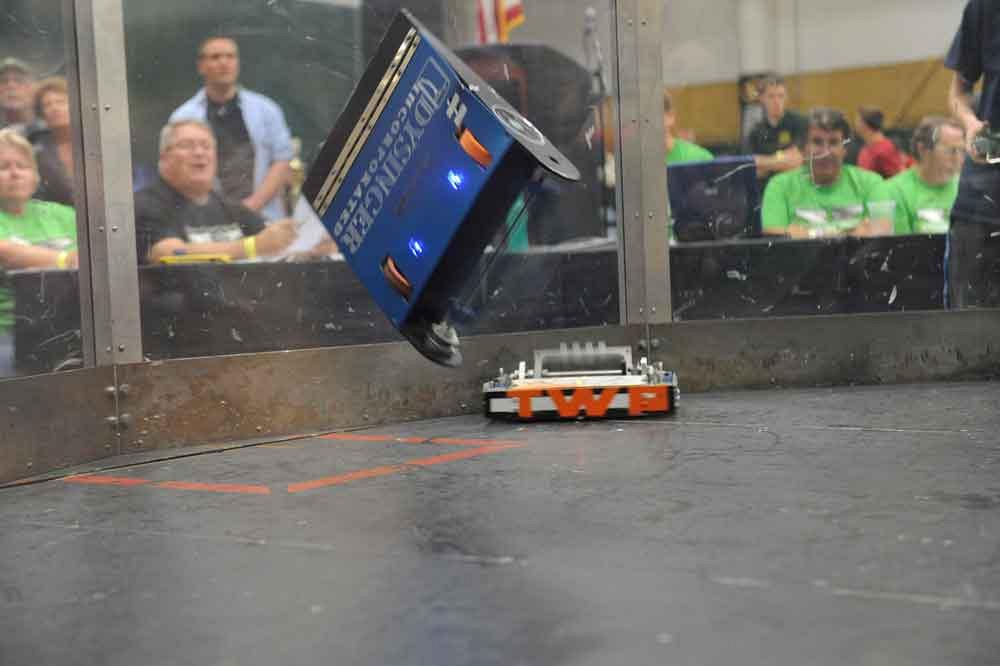
A bot gets clobbered during a recent Xtreme BOT competition in Dayton, Ohio, supported by, among other business leaders, a local custom fabricator.
A bot was clobbered. Time to regroup.
The recession required Staub to shift gears and rethink its investment strategy, but the overall strategy of full-service fabrication didn’t change. In 2009 the shop brought in welding and expanded its services just in time for the economic rebound.
A decade later the shop employs 40 people and has ramped up its capex. Next year it will be ramping up its cutting capability with a new laser and full automation, tailored for the company’s focus on production work, usually between 2,500 and 20,000 pieces a year, though in recent years volumes have grown beyond that, considering how high-speed lasers have been changing the stamp-versus-fabricate equation.
About Communication and Teamwork
Years ago a group of investors purchased the plastic injection molding company launched by Staub’s father. “They didn’t know anything about manufacturing, but they heard there was a lot of money in it, so they wanted to get in on it,” Staub recalled. “Well, that didn’t work out very well. The company ended up closing a few years later.”
The younger Staub wasn’t associated with the company then, of course, but for those still working there, in the phraseology of Xtreme STEM competitions, their bot was clobbered, and it was time to regroup.
The story no doubt shaped Staub’s view of manufacturing: It can be an unpredictable place for those unfamiliar with the business. The solution? Manufacturing shouldn’t be a secret, and it presents significant opportunities for people who know the business. How do you get more people to know about this business?
First, by speaking out. Staub is highly involved with the National Association of Manufacturers. In January he was named to the NAM Board Executive Committee. In July of this year he and his sister, along with Staub welder Corey Adams, were in the Oval Office with Donald Trump, Ivanka Trump, NAM President and CEO Jay Timmons, and Manufacturing Institute Executive Director Carolyn Lee, attending a ceremony recognizing the signing of the Pledge to America’s Workers.
The Staubs also have boosted outreach efforts locally, and the most obvious evidence of this began about five years ago. Staub had lunch with the owner of a machine shop several miles away, along with a friend who was publisher of the local business journal, but also passionate about manufacturing’s role in the community. All agreed that local schools didn’t do a good job spreading the word about the virtues of engineering and manufacturing employment. So they decided to do something about it. With that, Xtreme STEM was born.
“We’ve had about 400 kids go through the program this year,” Staub said, “and about 65 percent of them are actually going into manufacturing.”
The organization promotes manufacturing and engineering education not only through a fall and spring robot battle royal, but also through Xtreme 3D, a 3D printing competition and hands-on manufacturing awareness event. The most recent one involved the design of model wind turbines.
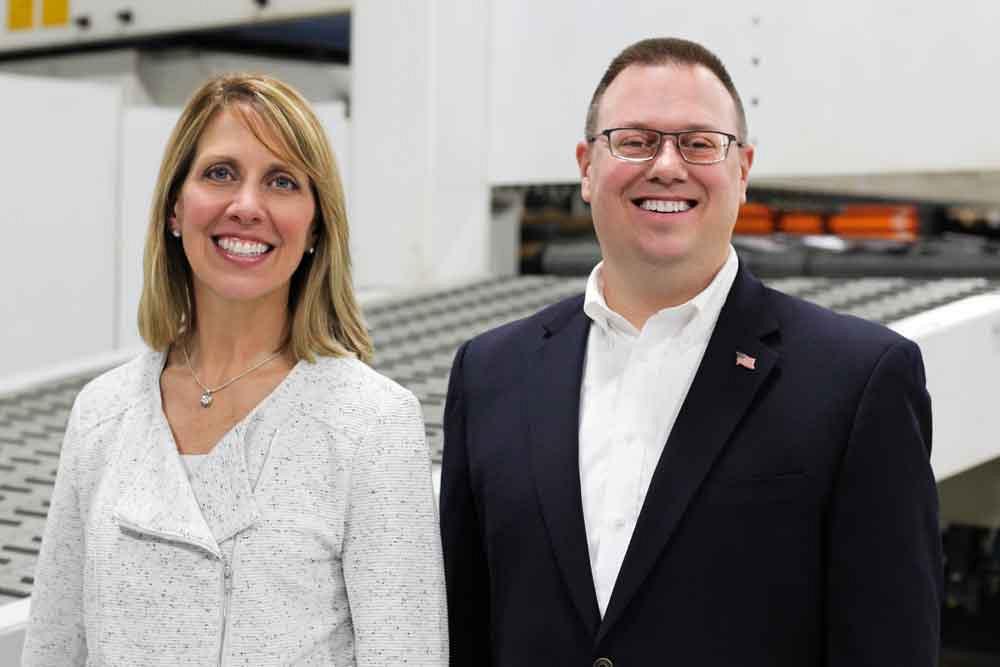
Steve Staub and his sister Sandy Keplinger launched Staub Manufacturing Solutions in 1997. It has grown from a small laser shop into a full-service fabricator.
Picture a middle schooler sitting at a computer, adjusting a CAD model of a wind turbine blade. She makes it long, short, changes the width in places, then hits “print.” She then places the wind turbine model in a small wind tunnel and measures how fast it spins. Does it spin faster or slower than the previous iteration? If it’s slower, what made it go slower? Students work with on-hand experts to learn about the principles of airflow. “And at the end of the day,” Staub said, “we choose a winner who had the best design.”
Learning basic principles of fluid dynamics is important, but as Staub explained, it’s the soft skills that make the event shine, including those work ethic values, patience, learning from past mistakes, and, again, teamwork.
Having the right team matters, and having everyone think alike isn’t necessarily a good thing. Staub should know; for the past 20 years he’s grown a business with his sister, in many ways his polar opposite. “Actually, it’s been 22 years,” he chuckled, “and we haven’t killed each other yet.
“I tend to think about the big picture,” Staub continued. “She’s much better at the details.”
Staub has the broad ideas; Keplinger thinks about the product mix, the value-adding work, and the impact on the company’s diversification. What percentage of the job is material cost? How much value are we adding? Keplinger is there to ask these questions and more.
“We make sure we have a broad spectrum of customers, that we don’t have all our eggs in one basket,” Keplinger said.
For the past year, for instance, Staub has had plans to bring in additional services that certain customers have been asking for.
“I’ve got that list too,” Keplinger said. “We know what we want to bring in, and we’re just waiting until we cross that financial threshold. We’ve got customers onboard; we’re just hoping to get [the work] to a certain level to bring it in-house.”
About Change
Gary Weldon remembers a different manufacturing industry. “I started working during a time when prints were actually blue. That was about the time technology was really starting to transform everything.”
Weldon is Staub’s new business development manager. As such he spends much of his time analyzing new markets, but he also devotes some time to Xtreme STEM. Those students are the future, after all.
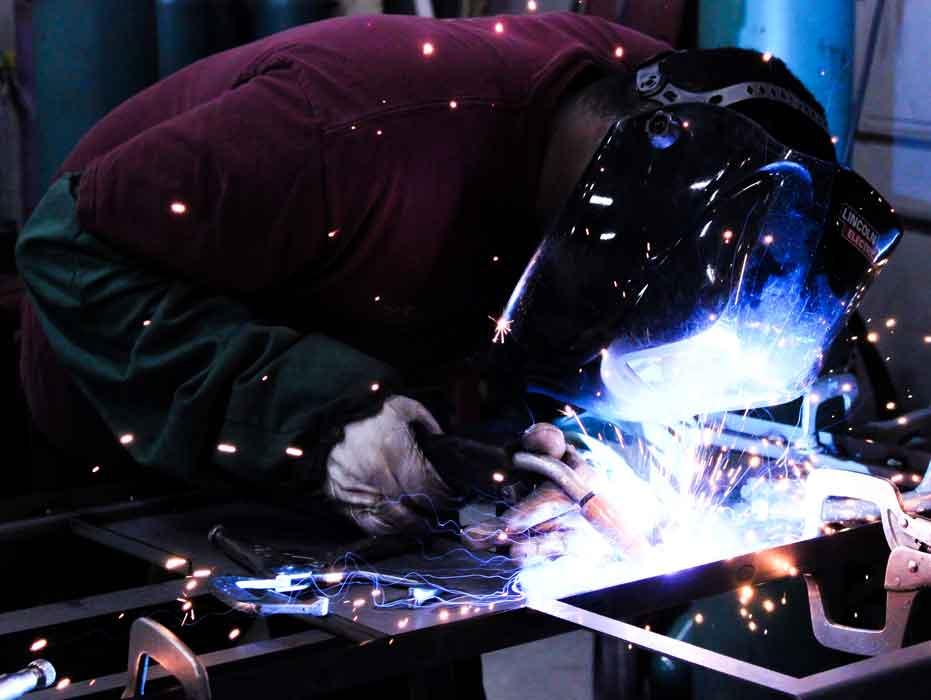
Staub transitioned from laser-cutting-only to full-service fabrication in 2009, during the worst of the downturn but ready to grab market share as the economy improved.
He agrees that those soft skills, including teamwork and communication, are more important than ever, not least because technology changes so quickly. Technology gurus are critical, but they also need to adapt as the technology changes.
“I started out as a lathe guy,” Weldon said. “I spent most of my time on a manual lathe, then into milling and machining. But the shop where I spent my first 15 years of my career used to have a bunch of hand-crank mills. Now they’re full CNC. So the kind of people they hire for what they do, it’s just transformed from the time I was there.”
Today manufacturing needs more kinds of people, and the industry needs to cast a wide net and attract those who would never have thought about a job in manufacturing—which of course is the whole point behind Xtreme STEM.
“During one [Xtreme STEM] event last year, I had a mom come up to me,” Staub said. “She told me she had no idea about manufacturing, that all this information was new to her and her son. The plan was for her son to go to school and get a business degree. But he loved working with his hands. He loved being on his bots team. So now he’s looking to attend welding school.”
Yes, his team’s bot spent several rounds getting clobbered. But the team regrouped. In a larger sense, he’s regrouping now, shifting from a four-year business degree and choosing the manufacturing career track. Will he find success? Only time will tell. But if his career path does get clobbered (in the metaphorical sense), he’ll know how to regroup and march forward.
About the Author

Tim Heston
2135 Point Blvd
Elgin, IL 60123
815-381-1314
Tim Heston, The Fabricator's senior editor, has covered the metal fabrication industry since 1998, starting his career at the American Welding Society's Welding Journal. Since then he has covered the full range of metal fabrication processes, from stamping, bending, and cutting to grinding and polishing. He joined The Fabricator's staff in October 2007.
subscribe now

The Fabricator is North America's leading magazine for the metal forming and fabricating industry. The magazine delivers the news, technical articles, and case histories that enable fabricators to do their jobs more efficiently. The Fabricator has served the industry since 1970.
start your free subscription- Stay connected from anywhere

Easily access valuable industry resources now with full access to the digital edition of The Fabricator.

Easily access valuable industry resources now with full access to the digital edition of The Welder.

Easily access valuable industry resources now with full access to the digital edition of The Tube and Pipe Journal.
- Podcasting
- Podcast:
- The Fabricator Podcast
- Published:
- 04/16/2024
- Running Time:
- 63:29
In this episode of The Fabricator Podcast, Caleb Chamberlain, co-founder and CEO of OSH Cut, discusses his company’s...
- Trending Articles
AI, machine learning, and the future of metal fabrication

Employee ownership: The best way to ensure engagement

Steel industry reacts to Nucor’s new weekly published HRC price

How to set a press brake backgauge manually

Capturing, recording equipment inspection data for FMEA

- Industry Events
16th Annual Safety Conference
- April 30 - May 1, 2024
- Elgin,
Pipe and Tube Conference
- May 21 - 22, 2024
- Omaha, NE
World-Class Roll Forming Workshop
- June 5 - 6, 2024
- Louisville, KY
Advanced Laser Application Workshop
- June 25 - 27, 2024
- Novi, MI
























